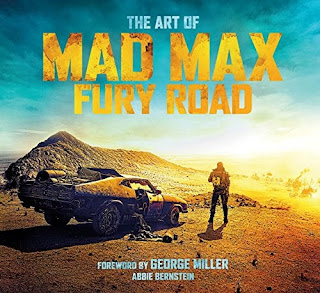Book - The Art of Mad Max: Fury Road
Read her review of the film here.
It feels a little odd trying to review a hardback book consisting of text, artwork and stills, about the art of a film in which everything is constantly in frenetic motion. The camera swoops and swerves and tracks in on people crashing their vehicles, hanging from cars, swinging on poles, bouncing on bungees or launching many and various projectiles. There are few moments of quiet or stillness. If there was ever a visual experience which encapsulated the notion of a ‘movie’ – of the moving visual image, Mad Max must surely be it. In Mad Max: Fury Road, it’s the same post-apocalyptic world that you’ll remember from The Road Warrior and Beyond Thunderdome, only bigger, dustier, brighter, glossier, and faster.
Director George Miller also uses the constant motion of the film to enhance its sense of scale - the rolling vastness of the land - the unending, unforgiving, unknowable desert and its wide, open sky play as important a role in this movie as do the vehicles. Ironically, larger-than-life characters seem appropriate in order to fill some of the hugeness of that forbidding landscape with something appropriately gargantuan.
The Art of Mad Max: Fury Road is the official companion book to the fourth much acclaimed movie of the Mad Max series. George Miller’s original post-apocalyptic vision subtly entered the popular consciousness and influenced a subsequent generation of writers and film makers. In this book one finally gets to chance to see how this seminal sci-fi vision was created and put on film.
The art in the book is pretty fantastic, communicating some of the originality, imagination and mayhem that has come to be associated with the Mad Max movies. It contains behind the scenes photos, concept art, prop and set design, as well as many extraordinary examples of the unique aesthetic and creative vision of the Mad Max franchise. It details the making of the film, complete with story boards and character portraits, and with a Foreword from the director himself. George Miller introduces the book with prologue from, I assume, what might have been the original script, before we are taken through the history of the production; complete with 1999-era storyboards and Peter Pound illustrations.
Miller maintains that one of the key design precepts is – “Even in the wasteland people make beautiful things. No matter how impoverished the circumstances, there are always among us artisans and artists able to create a strong utilitarian aesthetic.”
Where else can one start with an explanation of how the artwork came to be envisioned than with the story itself? George Miller stresses that the timeline and storyline of Mad Max is the core of all the design ideas. For those that haven’t as yet seen the movie, the basic story of Fury Road is this: It's forty five years since the collapse of civilization, resources such as water, food and oil are scarce. Survivors gather at the Citadel, a fortress controlled by the bloated and diseased tyrant Immortan Joe. Warrior Imperator Furiosa (Charlize Theron) aids his breeding wives in an escape through the Wasteland, to find the ‘Green Place’ - a refuge for women. On the way she forges a desperate alliance with Max Rockatansky (Tom Hardy). They embark on a high-speed race through the desert, pursued by Immortan Joe’s personal army. What follows is a high-octane Road War - and their chance for redemption.
The remainder of the book is split into chapters which deal with key areas from the film: The V8 Interceptor, The Road Warrior, The Citadel, Furiosa, The War Rig, Immortan Joe, The Gigahorse, Pursuit Vehicles, The Buzzard Attack, The Excavator, Coma the Doof, Miss Giddy, The Toxic Storm, Post Storm, The Wives, Nux, The Plains, The Canyon and the Rock Riders, Bigfoot Chase, Ornaments/Masks and Weapons, The Night Bog, Bullet Farmer, People Eater, the Vuvalini, and so on.
The hardcover book has 176 pages which feature photos, behind the scenes information, storyboards, some scenes or art that didn't make it into the film (including a map of the bullet-farmers citadel) and commentaries from almost everyone involved. If you are a Mad Max fan you won’t be disappointed, and even if you are just a fan of movies in general, this is fascinating material. There is also an 'artists inspired by' book being released at the same time and four comics which tell the backstories of the main characters, including Tom Hardy’s Mad Max, Charlize Theron’s Imperator Furiosa and Nicholas Hoult’s Nux. (The Inspired Artists book hit shelves on May 6, while the first prequel comic hits on May 20, all focused around the release of the movie).
Several ‘action’ directors have attempted to do what George Miller does in Fury Road – and the book captures some of the intensity and sense of heightened reality that may be found in comics and video games, and which has finally appeared in a live-action movie, staunchly filmed by Miller in the ‘old-school’ way. The Art of Mad Max: Fury Road is a comprehensive record of the making of such a film.
Note about the author : Abbie Bernstein - Author of Fantastic 4: The Making of the Movie, The Guild: The Official Companion, and The Cabin in the woods: Official Visual Companion. As well as also working on the Much Ado About Nothing: The Official Screenplay and Alien: The Archive books, Abbie writes regularly for magazines, including Assignment X, Fangoria, and Buzzy Mag.
Copyright R.H. Zelen – ©RenZelen 2015 All rights reserved.
Image Titan Books






Post a Comment